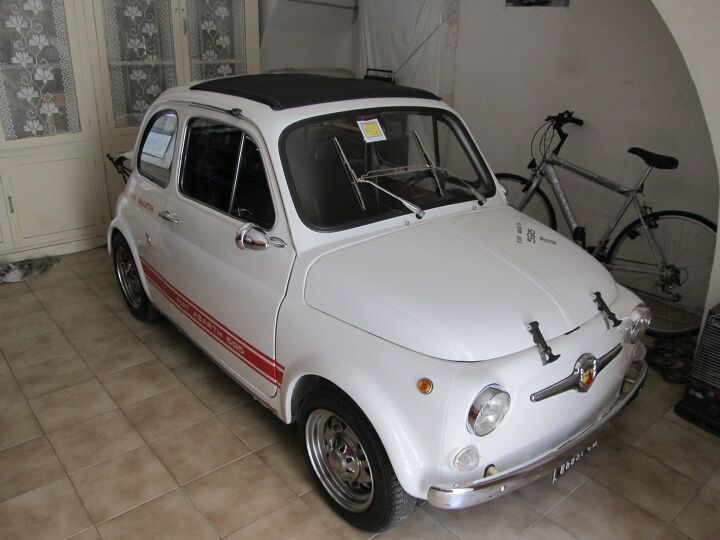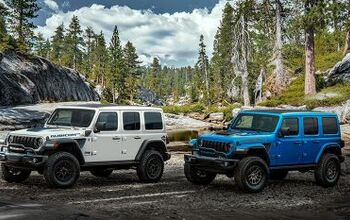Capsule Review: 1968 Fiat 500 (595) Esse-Esse Abarth

I haven’t been to Italy, in 21 years. My cousins and I are having dinner together for the first time in 21 years. If I didn’t already know it, I’d have learned it now: males with Italian blood are obsessed with cars. My cousin Nicola even works for FIAT, in the seaside town of Termoli.
“Are there Fiats at Chrysler stores in Canada now?” he asks.
“Just the 500,” I inform.
“That’s not the real 500,” says Angelo, his younger brother. Two hours later, we’re in my Nonna’s garage. He pulls the tarp off a stunning, perfectly restored 1968 Fiat 595 SS Abarth. “Quest’è la vera Cinquecento!” he informs me.
The trip from Montreal to Casacalenda, off the Adriatic coast, took 12 hours. My BlackBerry says 11 AM, my body says 5 AM. I haven’t slept in almost 36 hours. I am covered in airport guck. Now, somewhere in the Italian countryside, I’m going to drive a car without power steering, and 4 drums for brakes.
My cousin and I are shoulder-to-shoulder, elbow-to-elbow in the Esse-Esse. The cockpit is dominated by two things: a speedometer and an ashtray. These form perhaps the most succinct depiction that I’ve ever seen of the stereotypical Italian male persona. “Per capire l’Italia, devi guidare la macchina del popolo,” Angelo says. (“To understand Italy, you must drive the people’s car.”)
The roof encroaches upon my head; I have to adopt a Quasimodo-like hunch to get my eyes below the top line of the windshield and actually see out of the car. Obviously, Italians were shorter in the 60s.
I fire it up. It sounds like a cross between a Harley and an AMG V8.
“Il motore fa quanti cavalli?” I ask.
“27.”
I stall it twice just getting it out of the garage. The throws on the stick are epically long, like a day without bread. The friction point feels like it occurs randomly along the pedal’s journey, at a different point each time. My cousin says this transmission is going to feel different than what I’m used to. No shit.
At first, I’m frustrated. The cobblestone streets give the Fiat a serious case of epileptic tribulations. The town is an interconnected network of tiny, maze-like streets across rolling hills. Every intersection is a new challenge – combining octogenarian pedestrians, elevation changes, and ground effects in varying degrees. Every time we stop, facing uphill, I’m nervous about stalling. I can’t even use the parking brake to cheat, because, well, it’s a 43-year-old car and the parking brake hasn’t worked since Berlusconi’s first term in office.
Eventually, I manage to assemble a decent circuit around the village’s confusing streets. As the laps pile on, and I’m getting used to the car, I feel its personality emerge. I start to understand why Angelo wanted me to drive it.
First, the steering. The wheel is small; rotation requires a more than casual effort. It’s incredibly direct, lively without being twitchy. The front wheels react instantaneously, and bite immediately. It’s actually becoming fun to guide the car through the narrow streets of the old world.
I never fully understood the transmission, but I learned to work with it. Angelo forbade power shifts. He even forbade quick shifts. Everything had to be smooth, gentle, the way a cappuccino goes down on a sunny afternoon. Every time I put the hammer down, the Cinquecento responded enthusiastically, propelling me through the streets and up hills without trouble. Coupled with the sound it made, it was perfect driving nirvana.
Eventually, we left town and hit the mountain roads. We drove the sinewy mountain roads between Larino and Casacalenda. By drive, I don’t mean it in the newer American sense: casually direct a power-assisted-steering, with one hand while the buttery chassis isolates the driver from road’s more interesting features. Here, we drove. We drove with two hands on the wheel, looking not 50 feet beyond us, but 500, to know what we’d have to do. The shifts and revs had to be matched or the car’s performance would suffer. Braking distances had to be respected – there were no discs to save us, let alone ABS. Every curve, every hairpin, was full of excitement and required utmost concentration to execute.
Angelo and I were having the time of our lives. Driving the Fiat here was a man’s game. If you timed everything correctly, the 500’s engine would reward you with a thunderous roar. Driving lines had to consider elevation changes and deterioration. The 12-km drive left me with a profound respect for those who journeyed across this mountainous country in a Cinquecento.
As we pulled in to the garage, I began to reflect on how my experience had improved my understanding of Italy, as Angelo had suggested it would. My mind kept drifting to the VW Beetle, another car that was also una macchina del popolo. The Bug’s status as an automotive icon is beyond dispute; the Cinquecento itself was reverse engineered from the Bug.
However, the Italians understood what was missing from the Beetle. It was all left-brained, a perfectly built-car for a defined purpose. This would never suit the country of Da Vinci, the mathematician who painted the Mona Lisa. The car for il popolo d’Italia had to be more – it had to satisfy the left-brain and inspire the right. Enter la Cinquecento.

Latest Car Reviews
Read moreLatest Product Reviews
Read moreRecent Comments
- W Conrad I'm not afraid of them, but they aren't needed for everyone or everywhere. Long haul and highway driving sure, but in the city, nope.
- Jalop1991 In a manner similar to PHEV being the correct answer, I declare RPVs to be the correct answer here.We're doing it with certain aircraft; why not with cars on the ground, using hardware and tools like Telsa's "FSD" or GM's "SuperCruise" as the base?Take the local Uber driver out of the car, and put him in a professional centralized environment from where he drives me around. The system and the individual car can have awareness as well as gates, but he's responsible for the driving.Put the tech into my car, and let me buy it as needed. I need someone else to drive me home; hit the button and voila, I've hired a driver for the moment. I don't want to drive 11 hours to my vacation spot; hire the remote pilot for that. When I get there, I have my car and he's still at his normal location, piloting cars for other people.The system would allow for driver rest period, like what's required for truckers, so I might end up with multiple people driving me to the coast. I don't care. And they don't have to be physically with me, therefore they can be way cheaper.Charge taxi-type per-mile rates. For long drives, offer per-trip rates. Offer subscriptions, including miles/hours. Whatever.(And for grins, dress the remote pilots all as Johnnie.)Start this out with big rigs. Take the trucker away from the long haul driving, and let him be there for emergencies and the short haul parts of the trip.And in a manner similar to PHEVs being discredited, I fully expect to be razzed for this brilliant idea (not unlike how Alan Kay wasn't recognized until many many years later for his Dynabook vision).
- B-BodyBuick84 Not afraid of AV's as I highly doubt they will ever be %100 viable for our roads. Stop-and-go downtown city or rush hour highway traffic? I can see that, but otherwise there's simply too many variables. Bad weather conditions, faded road lines or markings, reflective surfaces with glare, etc. There's also the issue of cultural norms. About a decade ago there was actually an online test called 'The Morality Machine' one could do online where you were in control of an AV and choose what action to take when a crash was inevitable. I think something like 2.5 million people across the world participated? For example, do you hit and most likely kill the elderly couple strolling across the crosswalk or crash the vehicle into a cement barrier and almost certainly cause the death of the vehicle occupants? What if it's a parent and child? In N. America 98% of people choose to hit the elderly couple and save themselves while in Asia, the exact opposite happened where 98% choose to hit the parent and child. Why? Cultural differences. Asia puts a lot of emphasis on respecting their elderly while N. America has a culture of 'save/ protect the children'. Are these AV's going to respect that culture? Is a VW Jetta or Buick Envision AV going to have different programming depending on whether it's sold in Canada or Taiwan? how's that going to effect legislation and legal battles when a crash inevitibly does happen? These are the true barriers to mass AV adoption, and in the 10 years since that test came out, there has been zero answers or progress on this matter. So no, I'm not afraid of AV's simply because with the exception of a few specific situations, most avenues are going to prove to be a dead-end for automakers.
- Mike Bradley Autonomous cars were developed in Silicon Valley. For new products there, the standard business plan is to put a barely-functioning product on the market right away and wait for the early-adopter customers to find the flaws. That's exactly what's happened. Detroit's plan is pretty much the opposite, but Detroit isn't developing this product. That's why dealers, for instance, haven't been trained in the cars.
- Dartman https://apnews.com/article/artificial-intelligence-fighter-jets-air-force-6a1100c96a73ca9b7f41cbd6a2753fdaAutonomous/Ai is here now. The question is implementation and acceptance.











































Comments
Join the conversation
Great story and I love the current 500, having test driven the 2012 Sport with the 5spd. I'm figuring out how to wring the funds (lease with a buy out about a year later?) to get one here before long to replace my aging Ford Ranger.
A fantastic read!